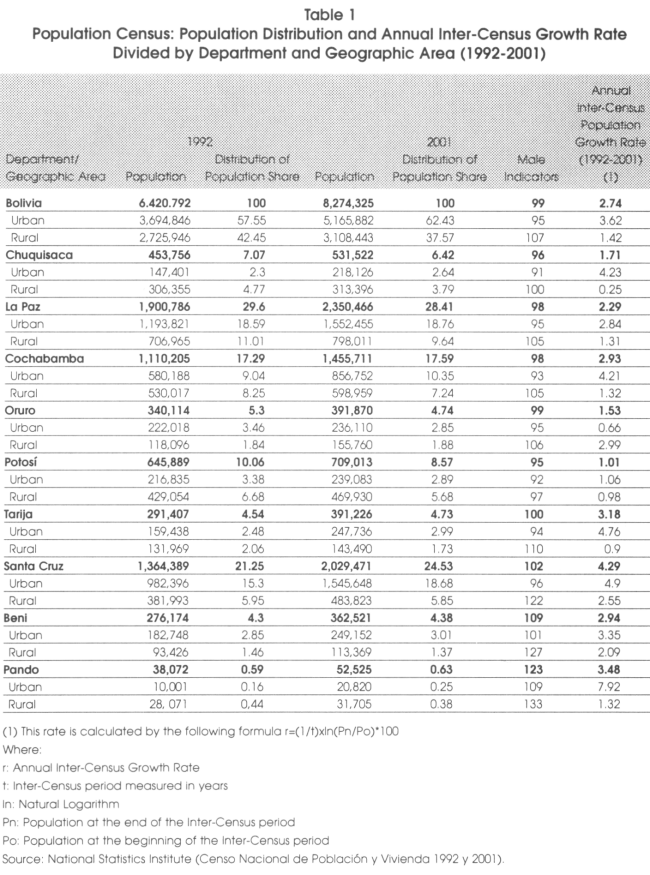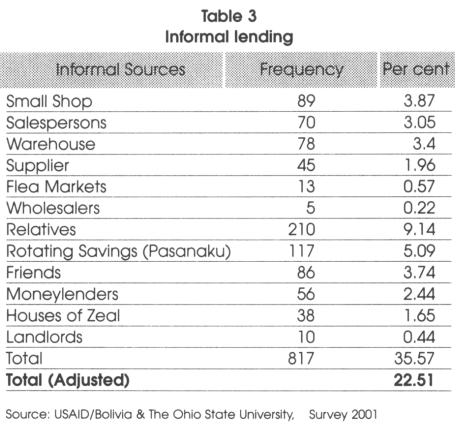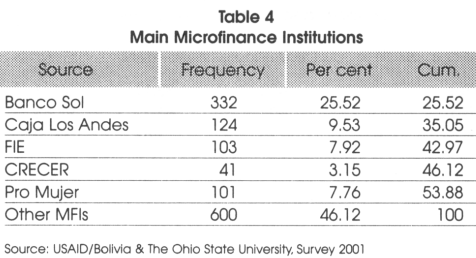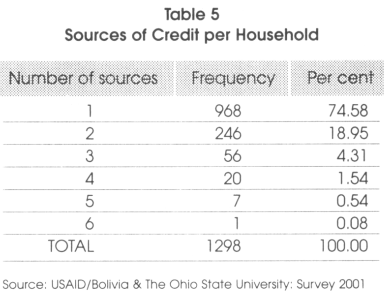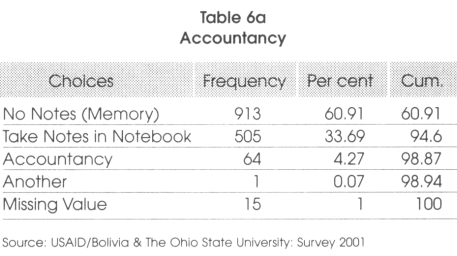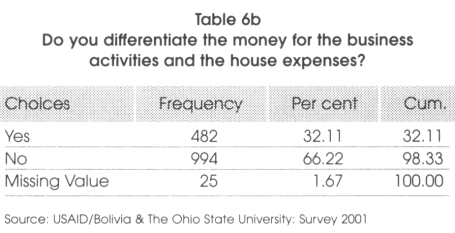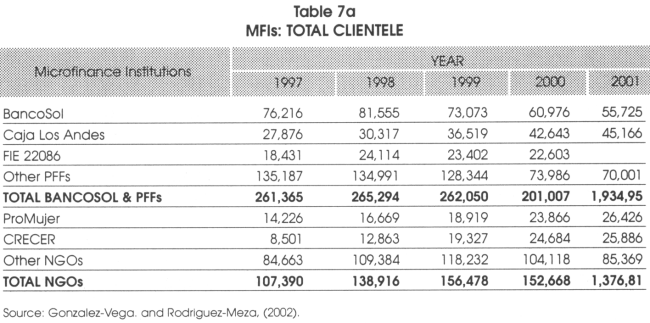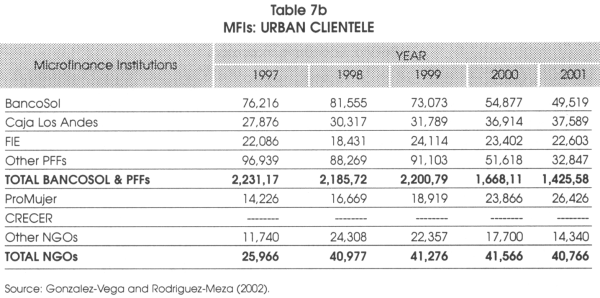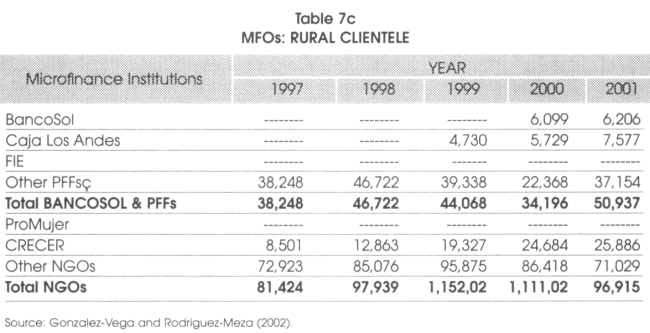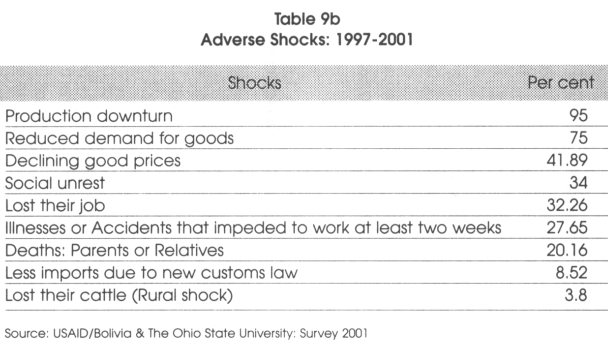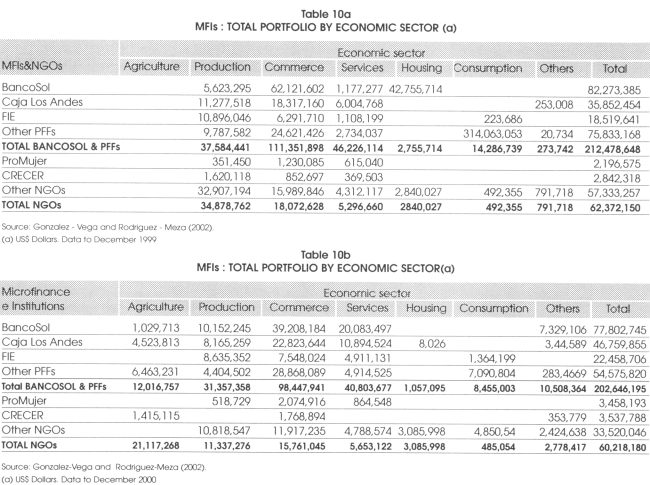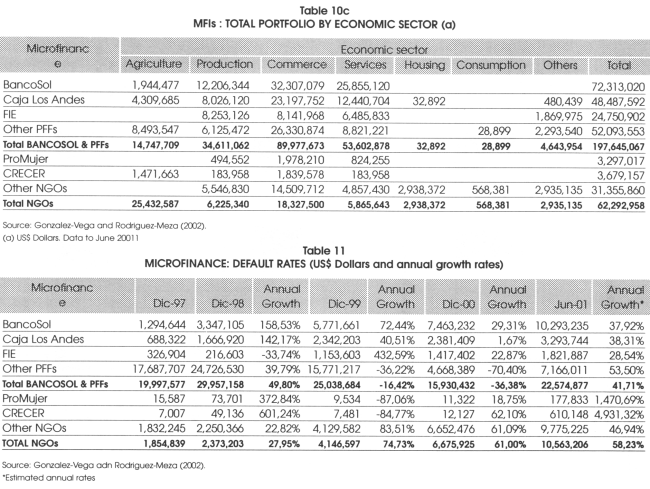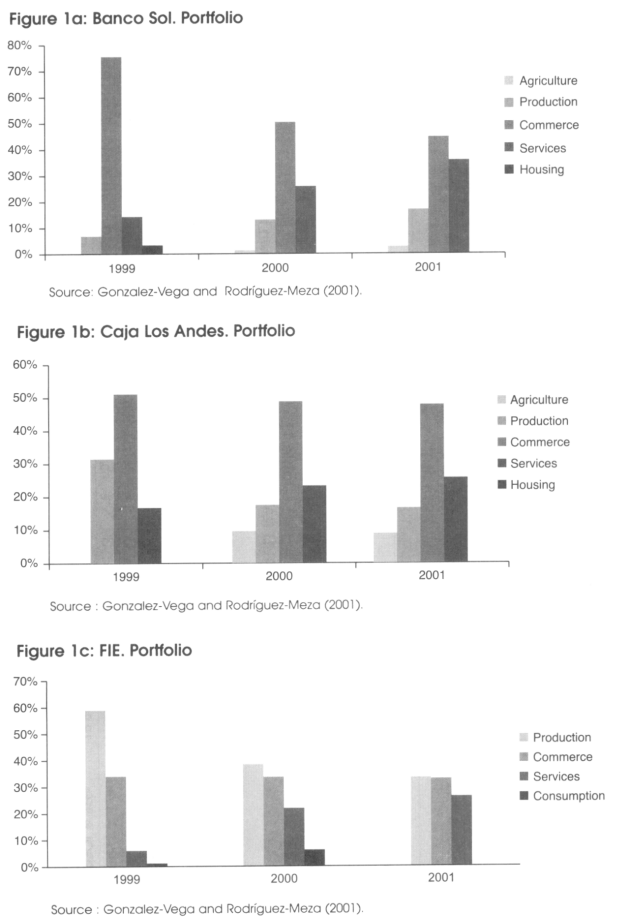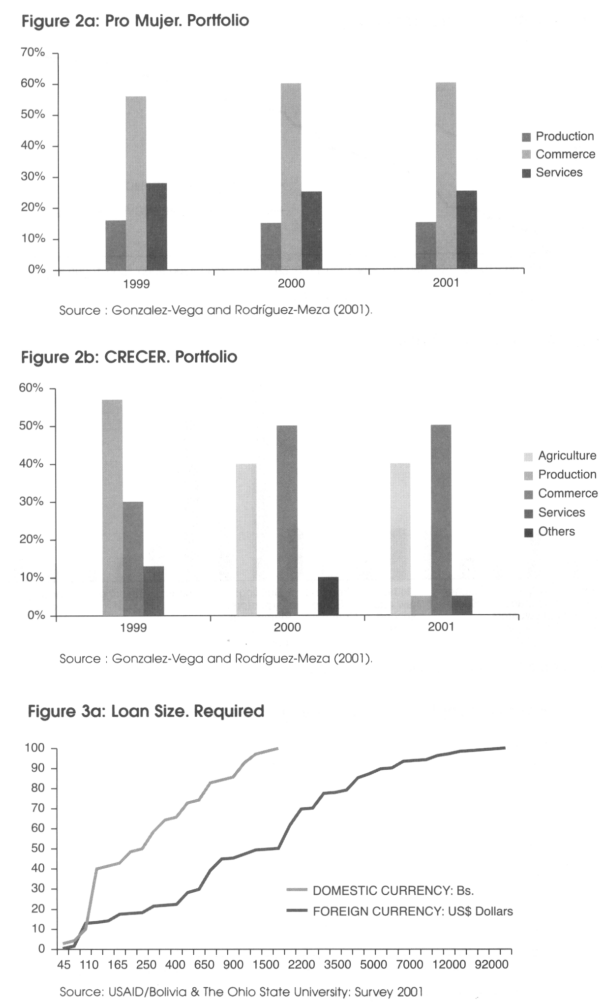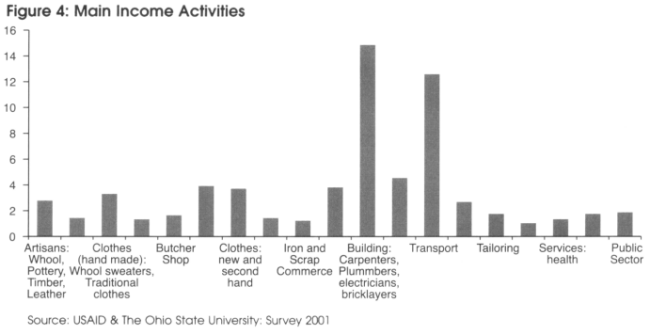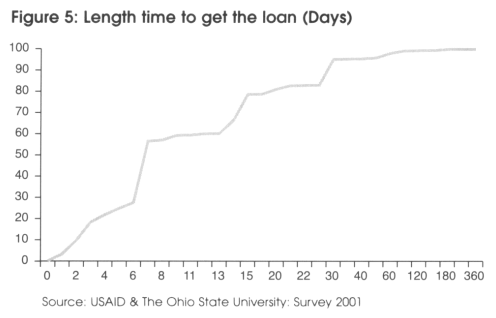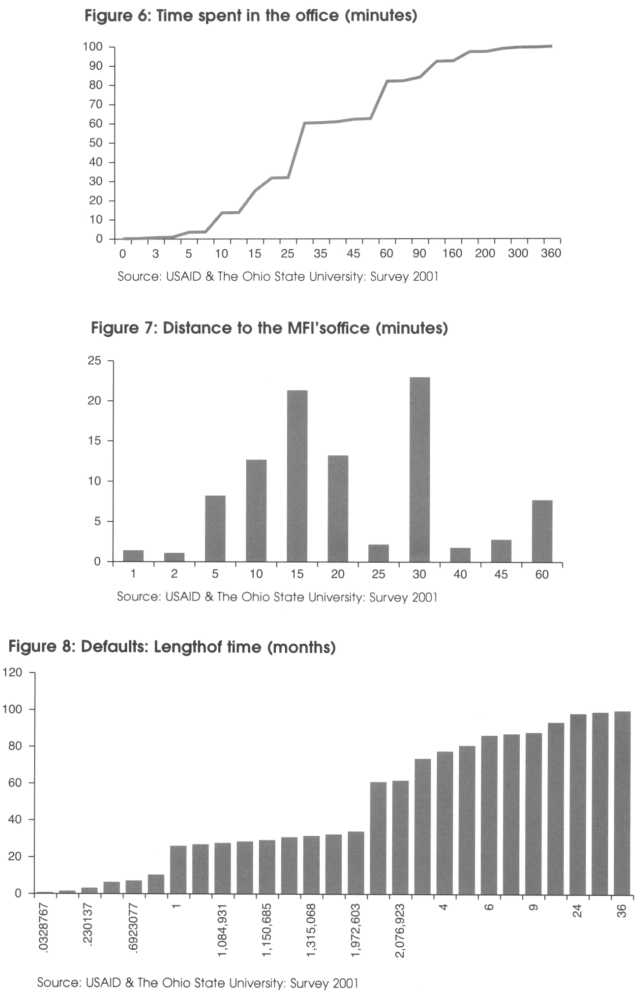Serviços Personalizados
Journal
Artigo
Indicadores
-
 Citado por SciELO
Citado por SciELO -
 Acessos
Acessos
Links relacionados
-
 Similares em
SciELO
Similares em
SciELO
Compartilhar
Revista Latinoamericana de Desarrollo Económico
versão impressa ISSN 2074-4706versão On-line ISSN 2309-9038
rlde n.8 La Paz abr. 2007
TRABAJO DE INVESTIGACIÓN
Shocks, Changes in Outreach and Lending Technologies in Microfinance: the Bolivian Experience*
Jorge G. M. Leiton-Quiroga*
Abstract
The Bolivian evidence shows that microfinance lending technologies are well designed to cope with different kinds of risk. The innovations provided in this financial sector show more strengths than weaknesses to overcome information asymmetries. Furthermore, group and individual loans are providing good mechanisms to cope with idiosyncratic and systemic shocks. Certainly, different microfinance technologies developed in Bolivia have shown good performance in terms of outreach and sustainability.
Resumen
La experiencia de las microfinanzas en Bolivia muestra que las tecnologías de crédito tienen un buen diseño para enfrentar diferentes tipos de riesgo. Las innovaciones realizadas en este sector financiero muestran más fortalezas que debilidades para superar los problemas de información asimétrica. De esta manera, tanto los créditos grupales como individuales proveen de buenos mecanismos para enfrentar los riesgos idiosincrásicos y sistémicos. Las tecnologías microfinancieras desarrolladas en Bolivia han demostrado un buen desempeño en términos de outreach y sostenibilidad.
1. Introduction
Overtime, economic theory has attempted to establish the importance of financial intermediation. It has been demonstrated that financial intermediation plays a key role in promoting economic development in developing countries. However, LDCs' financial intermediation has not been the central position that is important to enhance aggregate investment.
According to the developing countries reality, the lending technologies carried out by traditional banking systems, are not well designed. What LDCs' shows is a wide spread informal sector, low industrial capacity and high unemployment and underemployment rates. Certainly, there is a strong exclusion policy from the traditional banking system, closing this financial intermediation to the bulk of population.
Since the 1960s to the 1980s, state owned banks tried to provide financial services to poor people. These development strategies failed due to diverse factors. According to Besley (1994), the presence of a bank in a particular area is not sufficient reason to assume that the bank has chosen to operate there or that it is operating profitably. Charging non-competitive interest rates, below market rates, generates excess demand for credit, and bank operations have often been governed by rules for the selective allocation of credit.
Below market interest rates and selective allocation of credit, have social costs that can be identified as financial repression (McKinnon, 1973), without a market allocation mechanism, resources through credit schemes will be misallocated. The populist policies consequences in LDCs, led to reform the financial system and to improve resource allocation through financial liberalization and relaxation of government's regulations. (Besley, 1994)
The Bolivian experience shows that rural credit markets have rarely operated on a commercial basis. The Ohio State University group severely criticized the behaviour of these kinds of governments, like the Bolivian one, pointing to the fact that default rates were typically high and much of the benefit of these programs appeared to go to the wealthier farmers (Adams and von Pischke, 1992).
Also, within the last 20 years, it is interesting to mention that Bolivia suffered three important financial crises. The first one occurred by mid 1980s, due to acute financial repression. The second financial crisis happened by mid 1990s, due to weaknesses in regulatory and supervision rules1. The third crisis followed a boom in the financial system. The crunch is originated by the macroeconomic recession. It is important to keep in mind this last adverse shock due to its effect over the microfinance sector.
The financial crises, the traditional banking system credit technologies and, the emergence of microfinance in Bolivia, give the guidelines to follow this research. The traditional banking system is designed to provide credits to the wealthier population sectors in the country. High interest rates, high collateral standards and repayment frequencies are not suitable to the wide range of people that cannot fulfill these credit requirements.
Given these impediments, there has been an increasing interest from the international agencies (IADB, WB, USAID) to promote microfinance, in order to bring financial intermediation to those people considered as non-creditworthy.
In this way, microfinance is directed toward microenterprises, artisans, small farmers and the like. New lending technologies were adopted in order to help them improve their economic performance. The innovative credit technologies are designed in order to reach the poor and if possible the poorest of the poor. Microfinance is exploiting new contractual structures that can reduce costs and riskiness associated to small loans which rely on non-traditional collateral devices.
Following Morduch (2000), it is important to recognize that poor households demand access to credit, not subsidized credit or low interest rates. Thus, microfinance programs can charge high interest rates without compromising outreach and sustainability.
Through a measure of determined variables, the analysis follows towards the explanation of the contract terms and outreach: depth, breadth, scope, cost to users, worth to users and, length.
Also, within the analysis it is important to address the macroeconomic shocks suffered by Bolivia as a consequence of the East Asian Crisis in 1997, followed by the Russian, Brazilian and Argentinean economic crisis2. Aside these exogenous shocks, there were also endogenous shocks that affected the Bolivian economy, the introduction of the new customs law and the eradication of coca production represented a strong downturn in the economy due to the reduction of the informal sector activity and the coca under economy.
These macroeconomic shocks allow identifying idiosyncratic and systemic risks. The answer goes towards the conclusion that microfinance lending technologies are well designed to cope with this kind of risks. Furthermore, microfinance lending technologies are suitable to the population demand for credit. The innovations provided in this financial sector show more strengths than weaknesses to overcome information asymmetries.
Nowadays, Bolivia has a strong microfinance network, and the experience shows that these innovative lending technologies (group and individual loans) are providing good mechanisms to overcome information asymmetries and to cope risk (idiosyncratic and systemic). Certainly, different microfinance technologies developed in Bolivia have shown good performance in terms of outreach and sustainability.
The rest of the paper is organized as follows. Section 2 explains the data information. Section 3 gives theoretical issues about imperfect information. Section 4 evolves around microfinance and microfinance in Bolivia, providing insights about lending technologies, credit market analysis and outreach. Section 5 explains the microfinance performance in economic crisis periods. Finally, Section 6 gives the conclusions of this study.
2. Data
The data used in this study, belongs to a wide range of financial institutions in Bolivia. Statistical bulletins were used from the Superintendencia de Bancos y Entidades Financieras (SBEF), which is the government's office to keep a record of borrowers information, and to provide regulation and supervision frameworks along the formal financial system. Also the macroeconomic data comes from the Bolivian Central Bank (BCB) statistical bulletins and The IMF International Financial Statistics.
In addition, the microfinance projects funded by U.S. Agency for International Development (USAID) and carried out by Servicios Financieros Rurales (SEFIR) with the cooperation of Development Alternatives Inc. (DAI) provided helpful data and material supporting the achievement of this research3.
Finally, significant data from the Survey 2001 about Microfinance and Over-Indebtedness in Bolivia is also used in this study. The survey was funded by USAID and carried out by The Ohio State University (OSU) during the months of October, November and December 2001. The survey has been done through five Bolivian major cities, La Paz, El Alto, Cochabamba, Santa Cruz and Oruro.
People living in these areas account for 6,227,518 inhabitants and, 4,190,965 belongs to urban areas, therefore the data comprises about the half of the total population in Bolivia (Table 1). In this survey there were 1298 household interviews, spread in those major cities. The survey tried to collect data from urban, periurban and in specific occasions in rural areas4.
3. Imperfect Information
In this section, in order to address moral hazard and adverse selection problems, information asymmetries will be explained in detail according to the financial systems in general and, microfinance sector in particular.
The moral hazard problem highlights the lender's inability to recognize the borrower's actions. The lender's main source of risk is when individuals who are in debt, might slacken their efforts to make the project successful or they might change the type of project that they undertake (Ray, 1998).
Stiglitz and Weiss (1981) find that an increase in the interest rates affects negatively the borrower's behaviour, reducing the incentives conducive to loan repayment. Some borrowers obtain funding for a project from more than one source of credit, sometimes mixing formal and informal lenders. In theory, ach lender trust that everybody is monitoring the borrower's actions and this may lead to a similar situation as to a Marshallian inefficiency5. This entails that each lender put less effort on monitoring activities, leading to less vigorous and effective monitoring. Another problem surge when borrowers undertake several projects funded from different sources of credit. The effort made on each project may not be separable, and the result in one project will affect the payoff to the other lenders. These are common situations faced by microfinance institutions.
Another source of information asymmetries is the adverse selection problem. Besley (1994) defines this as follows:
Adverse selection occurs when lenders do not know particular characteristics of borrowers, for example, the lender may be uncertain about borrower's preferences for undertaking risky projects.
Adverse selection leads us to think about markets segmentation due to the information quality that can be known from each group of potential borrowers. One screening device to pull out poor quality borrowers is to use a collateral requirement (Stiglitz and Weiss, 1981)6.
Furthermore, it is difficult to monitor what is being doing with a loan. A loan may be asked for a specified reason, but afterwards it is used in another tasks. Due to bad use of the loan i.e. parties, holidays and in sum, non-profitable ends; can difficult the loan repayment process. Otherwise, the loan can be effectively used for the reason specified at the beginning, but the project for which the loan was asked for, may result in failure due to unforeseen events or high project riskiness. This may lead to involuntary defaults.
The second problem evolves around voluntary defaults and, result when the borrower doesn't find profitable to repay the loan, and this is intimately linked with contract enforcement problems and with weaknesses in legal systems across developing countries.
The contract terms will help to cope with these information asymmetries. Indeed, it is important to be cautious about the contract terms, in order to provide the right incentives to the borrower's repayment will. Also, it is important to acquire enough information about the borrowers' activities, minimizing the moral hazard and adverse selection problems.
From another point of view, involuntary defaults can be the result to exogenous shocks, which can diminish the borrowers' repayment ability. There are observable shocks that are systemic and common to all the population, like weather phenomena (droughts, floods, plagues) but this make no much problem because financial institutions will adjust the repayment process to the new scenario. The problem surges when idiosyncratic shocks affect a specific family or group of families. These shocks become difficult to observe and they need important insurance devices (Ray, 1998). Idiosyncratic shocks are more problematic because they are linked with process of repayment failure explained before, and to disentangle which case of failure matches to every situation becomes time and money demanding. This is a deep problem within microfinance institutions.
4. Microfinance
The financial system in Bolivia show three well-identified sectors. First, the traditional banking system, which is starting to improve their lending technologies towards microfinance. Second, Private Financial Funds (PFFs) are institutions mainly guided to the microfinance sector. These two types of financial institutions are abided by the SBEF. The third financial sector belongs to Cooperatives, Mutual and nongovernmental organizations (NGOs). Specifically, NGOs are not abided by the SBEF.
Almost two decades ago, microfinance organizations in Bolivia, started working with credit constrained people. After the macroeconomic crisis in 1 985, different NGOs started giving access to credit to poor people in urban and rural areas. Among them, PRODEM is the most famous one, because this institution was the cornerstone to fund BancoSol as the first formal and private institution oriented to microfinance.
During the 1990s, Bolivia gave more emphasis to the microfinance sector. Not only NGOs, but also formal institutions started working with microfinance technologies. The new banking system regulations allowed many NGOs to become PFFs, which acts as banks, but with limited banking functions. Even traditional banks started widening their scope towards poor people7.
In this study, the microfinance institutions that will be analysed are: BancoSol, Caja Los Andes, FIE, CRECER and ProMujer. The first three institutions, represents the formal lenders, and will be identified as Private Financial Funds, and the latter two institutions are non-governmental organizations8.
Also, informal money lending, works in the microfinance market. Their main attribute is that they have the ability to accept collateral in different forms such as jewelry, crops, reputation, etc. Informal moneylenders have much better information about borrowers' creditworthiness, activities and characteristics. This is important to highlight due to the information asymmetries problems across the different microfinance institutions and banking systems in general. Also, informal lending still is one important mechanism to cope risk and smooth consumption among poor people. This is highlighted by the fact that the results obtained from the survey 2001 shows an important informal lending component where borrowers and moneylenders are distributed in several categories. The results from the survey show that almost 23 per cent of people work with informal lending. (Tables 2 and 3)
Furthermore, microfinance technologies are spreading along the entire Bolivian financial system. Table 2 and 4 shows that 53 per cent of total sampling has microfinance loans and, the NGOs have almost 11 per cent of total market share. Traditional banks are starting to grant loans with microfinance technologies, and they have a small participation in the market with only 2.35 per cent. This result give an indication that taking into the account the number of microfinance institutions (MFIs) within the microfinance market, the five MFIs analysed here are the biggest and most important ones.
4.1. Lending Technologies
The credit technology try to determine optimal risk levels in order to diversify its portfolio and to choose the best clients i. e. the less risk clients with the purpose of fund profitable projects. In order to give a full explanation of factors that intervene in each microfinance transaction, the following analysis will introduce theoretical features about contract design and lending technology principles.
4.1.1. Contract Terms9
Moral hazard and adverse selection are the most important problems faced by microfinance institutions. Such problems will be reduced when the lending contract design gives the borrower enough incentives to be diligent and avoid default. This can be achieved through the contract terms: Interest rates, loan size, debt equity ratios, collateral and, through the lender's actions complementing the lending technology (Screening, Signalling, Monitoring, and Contract Enforcement). The lender's action can be identified as:
a. Information
Market Signalling is the image given by the institution. The institution should show its ability and willing to avoid defaults, according to its outreach and sustainability objectives.
Furthermore, Screening are the process which the institutions acquires information about every borrower. In the case of individual credit, it is important to determine the fungibility levels between house and firm expenses. In the case of group loans, it is important to recognize the wealth distribution among group members, and the incentives among them. As Ray (1998) affirms:
Screening efforts of a lender have enormous (positive) externalities: they prevent default on the loans of other lenders. However, externalities, as we well know, are not sufficient cause for someone to exert effort: he will only do so if it benefits him.
Note here, that the more microfinance institutions in the area will provide better conditions to cross information among them and avoid defaults. There will be a positive impact in the microfinance sector10.
b. Incentives
The contract design reflect the contract objective. More than specify interest rate levels and contract deadlines, need to give the right incentives to the borrower to avoid defaults. In this case the borrowers try to steer clear of losing collateral no matter if they are tangible or intangible goods. Examples among tangible collateral are: mortgages, goods, agricultural fields, crops, urban fields, houses, cars, firms. Among intangible collateral are: relationship with the client, reputation, future services, value of use, and access to credit. The intangible collateral represents high value asset for MFls clientele.
Monitoring actions provide information about the repayment process and the use of the loan by the borrower. These actions depend on each MFI monitoring strategy. This can differ due to the location: rural, urban.
Every microfinance institution starts the lending process by screening each borrower in order to assess repayment which can be divided in: Repayment capacity, acquiring information about the borrower's productive activities, state of wealth, and if the borrower has access to alternative sources of funding. Also, the lender must be sure to get back the loan taking into account the collateral value. The Repayment will, is a qualitative variable because its purpose is to assess honesty. This variable will be the result of the borrower and lender's behaviour.
Contract enforcement and defaults. Alternatives to another sources of credit strengthen default incentives. Computational networks help to provide a system of reputations in order to give discipline to the borrowers. If a borrower is known as bad risk by one lender, then the notice can be spread out and the lenders will be reluctant to give a loan to this person i.e. the borrower will be credit constrained in the future. Also, the rule of law is important to provide credibility to the contract terms and to ease judicial processes. In Bolivia, the SBEF helps the MFIs to cope with information asymmetries with the borrowers' credit histories.
The judicial system in Bolivia is extremely slow and inefficient, and represents higher costs in terms of time and money in order to execute overdue loans. The normal functioning of the entire financial system is obstructed by the factors mentioned above, and with more incidences to MFIs.
4.1.2. Lending Technology Principles
Most Private Financial Funds' lending technologies relies on individual loans. By the other side, NGOs are specialized in group lending due to their vocation to provide health and education services as well. Now lets see each of them in detail.
a. Private Financial Funds
Caja Los Andes and FIE work primarily with individual loans. BancoSol work with both lending technologies, individual and group loans, instead of, BancoSol's tendency to work primarily with individual loans. These institutions try to minimize the transaction costs through an efficient service oriented basically to each client characteristics. The products (loans and deposits) are valued by interest rates allowing the institution to cover costs and to be competitive. This shows the importance given to the institution's sustainability. (Rodriguez-Meza & Gonzalez-Vega, 2003)
These institutions encourage the clientele to minimize defaults (Signalling). This is done through a reputation mechanism and a long run relationship that acts as an intangible asset for the clients and the institutions. Due to this knowledge acquired along the time, clients remain asking loans from these MFIs.
For the PFFs, the human capital is extremely important, because their technology is highly labour intensive. The credit analyst gets deeply involved because gets a broad knowledge about the clientele activities, keep a repayment process record, and a clientele evaluation before giving the loan (Rodriguez-Meza & Gonzalez-Vega, 2003). In fact, the institution try to acquire all the possible information acting like moneylenders (specially in rural areas).
The credit analyst's education is important at the time the institution is hiring the personnel. When credit analysts are required for rural areas, the institution looks for people with education in agricultural issues at the university level. Also, the credit analyst is not always working in rural areas, due to the financial techniques training given by the institution, analysts can move to urban areas with no problem (Rodriguez-Meza and Gonzalez-Vega, 2003). These characteristics can be seen as a strong competitive advantage to the institution. Along time, the credit analyst becomes a central part because he/she has the social networks and all the information about the clientele. This constitutes an important asset for the institution.
After acknowledged the repayment capacity and repayment will, the credit analyst design the contract terms according to the client characteristics, the collateral provided, the loan size and the client's credit history with the institution or with another institutions.
Collateral is not always required. If the loan is less than a minimum amount specified e.g. 7500 US$ for Caja Los Andes, objects from the house or the business activity are widely accepted, or in the case of agriculture, future crops and cattle are accepted as well". For bigger loans, the collateral asked is the same as the collateral asked by commercial banks, i.e. machinery, vehicles, mortgages, etc.
In most of cases, the collateral intrinsic value is ostensibly less than the value given by the owner. The client feels harmed if he/she loses the collateral. The collateral is almost never took off and if the MFI is pushed to take this punitive action, it is because the MFI want to show that makes credible commitments and, it is only a matter of credibility. The collateral has not much value for the institution.
b. Non Governmental Organizations
CRECER and ProMujer's lending technologies provide an interesting challenge and the reasons are as follows. First, CRECER and ProMujer are not common credit organizations. They have group credit technologies and a combined program between education and financial services. Group loans rely on joint liability.
These two NGOs are female oriented, i.e. they provide credit to women. If one group member fails to repay the loan, the other group members have to repay the loan. CRECER is more rural oriented and ProMujer is more urban and periurban oriented.
The process starts with the creation of a group of borrowers and the organization ask for a deposit of at least 10 per cent of the loan received by each member of the group; this is done at the beginning of each cycle12 (Quiros and Rodriguez-Meza, 2003). This in fact constitutes a compulsory saving, and acts like an encourage mechanism to promote savings among people with no experience with financial institutions. From another point of view, this compulsory saving acts as a tax, or as an entrance cost to the communal bank.
From cycle to cycle, each borrower increase the loan size, and the maximum increase is 50 per cent of the loan received in the previous cycle. Group members have to attend once per week to meetings in the NGO, where they receive education concerning household economics, how to knit, and the like. The borrowers spend up to four hours in these meetings.
One of the problems with this lending technology is self-selection bias, because all group members know each other very well and most of times they are relatives or friends. The groups are created mainly by social networks and not by reducing information asymmetries and project riskiness.
4.2. Credit Markets Analysis
4.2.1. Credit Markets Characteristics.
Credit Markets are divided in two main groups: those markets covering urban areas and those markets covering rural areas. In urban areas, credit markets are divided by the sector where the loan will be used for, i.e. production, commerce, services, housing and others. In rural areas, credit is commonly assessed as agricultural credit. In Bolivia, it is interesting to note that most of times credit cannot clearly be identified as rural or urban. This problem surges because there is no equal meaning to the term rural among MFIs. For some, rural means the person who effectively lives in the countryside, for other MFIs the term rural is subject to the distance where the borrower lives from the MFI's offices. Also, there are many mixed activities e.g. the small farmer work in commerce activities during the fall period which makes the analysis more entrenched.
However, identifying common market characteristics will solve this problem. According to Ray (1998) within microfinance markets there are common features, which are: Informational constraints (explained before), market segmentation, interlinkage, interest rates variation, rationing and exclusivity.
Market segmentation occurs when formal lenders target people and they will provide credit only to the target group. People outside the group will be excluded and will not benefit from the microfinance program. However, self-exclusion occurs as well, potential clientele did not apply for credits due to the institution image or institution reputation, and this reduce the institution's screening costs (Quiros and Rodriguez-Meza, 2003).
There is a wide range of international donors, which want to promote microfinances to overcome exclusion due to market segmentation. These promotions are not uniform, showing asymmetries among recipients and, become an impediment to identify comparative advantages and disadvantages among microfinance institutions. These subsidies increase market distortions and reduce competitive opportunities, reducing incentives to develop microfinance technologies and financial services.
Table 10 and Figures 1 and 2 explains how market segmentation can be identified by target population according to their main income activities. Credit to agriculture was absent in the target population, even for the NGOs that are supposed to cover more rural areas than PFFs.
In 1999, PFFs portfolio evolution is as follows. Commerce was the major sector within microfinance with 52 per cent of total portfolio, followed by Services with 22 per cent, Production accounted for almost 1 8 per cent, and Consumption with 7 per cent of total portfolio. NGOs performance showed 56 per cent in Production activities, 29 per cent in Commerce, 9 per cent in Services, and 5 per cent in Housing. In 2000, the most surprising feature is that all microfinance institutions started working in rural areas. Agriculture activities augmented its participation to 6 per cent for PFFs and to 35 per cent for ProMujer. In 2001, the microfinance institutions portfolio remained the same as in the previous year, but in addition consumption loans almost disappeared.
lnterlinkage. There are interlinked transactions that can be translated as credit. In urban areas, suppliers give credit to retailers in the form of products, which can be paid at later time. In rural areas, moneylenders are also wealthy landlords, or traders. In this case, it is known that interest rates are almost imperceptible, or hidden. Specifically, in interlinked transactions, interest rates are almost absent (Ray, 1998). This type of data is difficult to collect, and it is almost impossible to disentangle the possible interlinked transactions.
Table 3 shows some possible interlinked transactions among informal sources of credit. Can be highlighted transactions between warehouses, suppliers, wholesalers and landlords.
Interest rate variation. Formal and informal interest rates have a lot of variation, and they differ up to geographical location, the source of the funds they belong e.g. private agents, international donors (subsidies), and the characteristics of the MFI and the target population.
Interest rates play a key role in determining demand and supply for credit. Interest rate level affects the lender's portfolio and due to the possibility of default, lenders will not use the interest rate that clears the credit market. This will lead to a rationed credit market. Interest rates will vary across MFIs due to the repayment time length, the loan size, the collateral provided and the borrower's reputation.
The survey data shows that 48 per cent of clientele feel comfortable with the interest rate levels and 46 per cent feel uncomfortable. This may lead to think about the distortions introduced by subsidized interest rates showing non-market equilibrium interest rates13
Rationing can be explained by the situation where the borrower wants to increase the loan size or the number of loans but the lender is not willing to lend more (Ray, 1998) Also, rationing is related to the case of segmentation.
Note that not all of borrowers bear the same amount of risk. When risk is observable, the lender can select its clients, or use the interest rate as a screening mechanism for example charging higher interest rates to the riskier clients. But in practice is not as easy as it seems. Formal lenders and semi formal lenders, cannot set different interest rates for different borrowers, at the end the interest rate is the same for all. At the prevailing interest rate, there must be clients that cannot obtain loans, and the interest rate must be higher enough to attract on average good borrowers (Stiglitz and Weiss, 1981). In this sense, interest rates are not extremely high. Otherwise only high-risk borrowers will ask for loans.
According to the survey data, the cumulative distribution function in Figure 3 shows that 50% of borrowers ask for loans in domestic currency of Bs. 180 or less14 . The maximum loan size asked in domestic currency accounts for Bs. 1,000. Also, 50 per cent of borrowers ask for loan of 1,000 US$ or less, and the maximum loan size asked in foreign currency is 92,000 US$'15
In contrast, the 50 per cent of the borrowers effectively received a loan in domestic currency of 210 Bs. or less, with a maximum loan size received of. 1,000 Bs., this entails that there is no credit rationing in domestic currency. In foreign currency, 50 por ciento of borrowers received 800 US$ or less (there is a 20 per cent difference per loan asked and received) The maximum loan size received in foreign currency is 92,000 US$.
Exclusivity. Lenders typically dislike situations in which their borrowers are dealing with more than one source of funding. In Bolivia, almost all the formal, and semi-formal microfinance institutions use this system as a screening mechanism. The exclusivity is designed to overcome over-indebtedness problems. This is addressed by the regulated MFls, through the SBEF, who provide information about the borrowers' credit histories.
Nevertheless, MFIs take care about the number of loans each borrower have at the present. An example of this, is clearly identified when 75 per cent of the interviewed people said that they have only one source of credit, 19 per cent have two sources of credit and 7 per cent have between 3 and 6 sources of credit. (See Table 5).
4.2.2. Clientele characteristics
According to Ray (1998), the demand for credit can be divided in three major parts: capital for production (fixed capital), credit for working capital and finally the consumption credit.
In addition, the economic characteristics in Bolivia help to explain two well-defined economic sectors. First, the industrialized and productive sector which is not completely spread out across the country. According to the Lorenz curve and the Gini coefficient for 1999, the country's income distribution represents the 57 per cent of income to the 20 per cent richest people and the remaining 43 per cent of income goes to the 80 per cent of the people, explaining wide differences among population's income. (IMF, 1999).
Second, the non-industrialized sector is divided among people working in government institutions, wage labourers, small farmers and the informal sector. The informal sector is separated in commerce, carpentry, plumbing, informal commerce, bricklayers and the like.
The clientele characteristics can be summarize as follows:
The microfinance target population belong to the informal sector in Bolivia. Figure 4 shows the main activities. Carpentry, Plumbing, Bricklayers account for 15 per cent of the sample, followed by transport with 13 per cent and sale activities divided in: food sales, clothes, crafts, tailoring, health services.
There is no division between the firm and house expenses. Accountancy is not driven in standard ways and they mix firm and house budgets. Most of people use to have no accounting methods, and then rely on their memory or informal notes. Table 6 shows that 61 per cent of total sampling has no accounting methods, and only 4 per cent of total sampling rely on formal accounting.
There are high vulnerability levels due to adverse shocks. People live unprotected against adverse climatologic phenomena, macroeconomic shocks, or intrahousehold adverse shocks. The survey data shows that 90 per cent of total sampling suffered adverse shocks16
Also, high mobility levels are important. People from rural areas use to migrate to urban areas looking for better economic living conditions. It is observed that there is a seasonal migration to cities. During the drought season, rural people use to move to urban areas looking for temporary jobs, and then they come back to the countryside to cultivate the fields.
4.3. Outreach
In general, the MFI's success relies on the ability to give financial services to the target population. This ability is defined by outreach. In microfinance, outreach refers to a wide range of possible financial services given to poor clients. Consequently, outreach must be measured from different points of view (Navajas ef al., 2000): Breadth, Depth, Cost to users, Worth to users. Scope and Length.
Breadth identifies the number of clients. It is advisable to get more breadth in order to fulfil the MFI's objectives, and also will reflect the MFI's sustainability.
PFFs' clientele in urban areas reduced from 223 thousand in 1997 to 142 thousand in 2001 (see Table 7). In 2001 clientele numbers were still going down but not at the same pace as in the previous years. The most important decline in clientele comes from BancoSol and 'Other MFIs' indicating that commerce activities and consumption credit are the main sources explaining this clientele decline. Caja Los Andes and FIE, remained growing its clientele numbers. ProMujer had the opposite behaviour to BancoSol, and they were growing by 57 per cent in the same time period.
BancoSol and Caja Los Andes expanded their activities to rural areas and they clientele numbers grew ostensibly since 1999 to 2001. CRECER clientele grew threefold (see Table 7).
The next variable to explain is depth of outreach. Depth is related to the social and economic issues. It is commonly associated to target population with specific characteristics e.g. women, poor people, indigents. This indicator reflects the ability of each MFI to design innovative lending technologies to overcome traditional barriers to give financial services to the target population. If the target population are people below the poverty line, the severity of poverty will be fundamental making more difficult the lending technology design.
When MFIs focus more on poor people, surges a trade off between outreach and sustainability. Navajas et al. (2000) demonstrated that MFIs are attending people situated around the poverty line, and there is no much people in the bottom of the poverty scale indicators. Specifically, PFFs try to focus more on urban areas and rely in less poor people. PFFs' target population were changing the last years, BancoSol and Caja Los Andes had a preference to give loans for commerce activities, and since 1999 (Caja Los Andes) and 2000 (BancoSol) started granting loans to the agriculture sector. FIE changed the target population from Production activities to commerce as well.
The NGOs, specifically ProMujer, had the same target policies as PFFs. In contrast, CRECER showed strong policies to target production activities. These policies changed in 2001, where CRECER shows more commerce activities in its portfolio share. (See Figures 1 and 2). This is an indicator that the target population are not the poorest of the poor, instead of, they are prosperous small entrepreneurs devoted to the commerce activity.
The Cost to users help to explain all the costs that the client incurs while getting a loan. Contract terms have to suit the client's needs. Micro entrepreneurs put high value in terms of simplicity and speed of the lending process. It is important for micro entrepreneurs to have access not only to loans but to deposits as well. These aspects highlight the importance to develop a wide range of financial services. Finally, the quality of outreach is important to determine long-term relationships between borrowers and lenders, and this will be an indicator of sustainability.
The time length to get a loan constitutes sunk costs to the borrowers. It is important to help the borrowers to reduce the time length to get the loan. According to the data, the 56 per cent of the borrowers get the loan within 7 days, 80 per cent of the borrowers get their loan within 20 days (see Figure 6).
Additionally, the time length the borrower spend in the office every time he/she have to go there for any purpose e.g. repay the loan, constitutes an incentive/disincentive in terms of contract enforcement. Around 60 per cent of borrowers takes 30 minutes or less to do that (see Figure 6). Also, it is important to assess how far the MFI's offices are from the borrower's main activities or house location. This entails costs in terms of transportation and time. The 55 per cent of borrowers need within 5 and 1 5 minutes to get the MFI's offices and the 81 per cent need within 5 and 30 minutes (see Figure 7). These results show that there are good conditions to reduce the cost of the loan and improve the MFIs' efficiency.
The Scope of outreach reflects the variety of financial services offered by the MFIs. In this category, PFFs offer wide range of financial services from loans, savings accounts, long-term deposits, and facilities to insurance devices. Among NGOs, there are savings mechanisms' , and they provide health and education assistance to the clientele.
The length is intimately linked with sustainability. It is an indirect indicator of this variable. Length is the permanence of the MFIs in the long run. Borrowers give high value to this variable because they build up a relationship based on trust, and clients value their reputation and credit histories. Most of PFFs operate at least ten years in the microfinance market and the same applies to NGOs.
Furthermore, the worth to users represents how much a borrower is willing to repay the loan. In other words, default rates will be an indicator of this variable. The survey data helps to explain that 76 per cent of total sampling had problems to repay the loan (this does not mean defaults). But the will to avoid defaults is reflected by the fact that: 66 per cent of total sampling had to work more, 47 per cent used their savings, 23 per cent had to sold objects from the household (cars, refrigerator, etc) and 27 per cent asked for help to their relatives.
Also, 51 per cent of borrowers incurred in default. But, 76 per cent of them were in default less than 30 days. The remaining 24 per cent incurred in default more than 30 days, from which 60 per cent were 2 months or less in default (see Figure 8).
From another point of view, Table 11 shows that PFFs default rates grew on average almost 50 per cent of total portfolio on 1998, and then default rates started decreasing until 2001 when they raised by 41 per cent18. In the case of NGOs, default rates became more than a problem. Table 11 show that default rates grew in 1998 by 372 per cent for ProMujer and 601 per cent for CRECER. The following years these two NGOs improved their default rates but in 2001 they grew again by 1470 per cent and 4931 per cent for ProMujer and CRECER respectively.
In the following section, the macroeconomic shocks will help to explain these default rates sharp fluctuations, specifically for NGOs.
5. Systemic and Idiosyncratic Risk
Bolivia is walking through a severe economic crisis. Social unrest is growing steadily, and uncertainty at political levels constitutes a big problem as well. Since 1999, the economic growth started to slowdown and in 2001 the country showed no economic growth. This sudden change in the country's macroeconomic performance drives to serious changes in the financial system. The exogenous crisis, lack of investments and dwindling domestic demand, led to reductions in the informal sector activities.
The New Customs Law helped to reduce informal imports19 also, coca eradication policies unleashed dangerous social unrest. All of these events constitute adverse shocks to the microfinance sector.
These regulatory shocks are an example of how systemic risk affects the microfinance organizations portfolio. Social unrest led to strikes and blocking major highways in the country, putting in danger agricultural exports enhancing the economic crisis. These events help to address the fact that microfinance institutions concentrate its portfolio primarily in the informal sector, leading to problems in microfinance portfolio.
Bolivia also suffers from declining terms of trade (Leiton-Quiroga, 2000). Aside natural gas exports, Bolivia faces strong exports value contractions. (See Table 8). By the other side, there were import contractions as well, meaning that informal commerce decline has negative effects on the microfinance sector. The urban unemployment rate increased from 5.3 per cent in 1998 to 7.3 per cent in 2001.This unemployment increase will lead to underemployment increase in the same direction.
These macroeconomic shocks constitute a source of systemic risk, which can lead to changing client's moral hazard behaviour. On the other hand, idiosyncratic risk is more difficult to observe and it depends on each client activities and sources of risk.
Microfinance technologies (individual and group loans) have the ability to cope with idiosyncratic and systemic risk. In the case of individual loans, clientele, loan and collateral characteristics are screened at the beginning of the process and they are better designed to understand intrahousehold income fluctuations. This technology is designed according to each client characteristics and will be more suitable to cope with idiosyncratic risks. Furthermore, individual loans had no problem with systemic risks due to the country's economic downturn. This is demonstrated for PFFs (interestingly not for BancoSol) in Tables 7 and 11 can be seen that Caja Los Andes and FIE were growing in clientele numbers and default rates were remarkably reducing.
BancoSol's performance is difficult to explain because works with both lending technologies, and its portfolio is highly concentrated in commerce activities. Also, NGOs performance in terms of defaults is conclusive, in the sense that they had a lot of problems with raising default rates. One possible explanation is that groupal loans are having difficulties with systemic risk. When adverse shocks affects all the population, all group members will be in the same situation and the group will not be able to fulfil the joint liability in the presence of considerable defaults.
In order to have a better understanding about these default rates fluctuations, it is important to review the explanations given by the interviewed people, whom link their default rates and reduced repayment capacity (not repayment will) to the macroeconomic crisis.
In relation to systemic shocks, 90 per cent of the total sampling said that there was a production reduction during the economic crisis, especially since 1999. The specific problems most identified by the sampling population were: declining product prices, declining sales and reduced demand for goods. Moreover, people identified social
unrest as a crucial cause of economic downturn and default problems. It is interesting to point that only 9 per cent said that they had economic problems due to the new customs law. Note here that, due to smuggling activities, people will be reluctant to address this new customs law as a problem (see Table 9).
Furthermore, idiosyncratic risk was also a source of increasing default rates. Deaths of parents and relatives, illnesses and accidents within the household that impeded to work at least two weeks and, unemployment rates were rising. Agricultural shocks were almost absent, only 4 per cent of total sample said that they had problems with cattle or crops.
These events had its consequences on the living activities among the population. The most impressive answers was that 72 per cent of total sample said that they had less food in the house, 28 per cent stopped building their houses, 20 per cent said that they stopped to do investments and 37 per cent reduced their social activities e.g. parties, weddings, meetings and the like.
It is worthwhile to address here is that there were almost no agricultural shocks. The theory assumes that before getting into rural markets, microfinance institutions first develop a strong urban microfinance network that allows them to cover sunk costs in rural areas (Gonzalez-Vega, 2003). These costs are associated to the lack of additional services like insurance markets, sometimes there are no good roads (not paved roads), and the population is not concentrated in closed areas.
In this sense, it is important to highlight that since 1999, the PFFs started granting loans in rural areas, this perfectly matches with the beginning of the macroeconomic crisis in 1999. According to the survey answers, the crisis affected more urban areas rather than rural areas, and this is the reason for changing the focus towards agricultural areas. This behaviour suggests diversification portfolios towards rural areas, i.e. understanding a rural area as a cushion for systemic shocks especially helping MFIs to diversify urban risk (see Table 7).
6. Concluding Remarks
Bolivia has developed a strong microfinance network. The five main microfinance institutions analyzed here belongs to the most important ones in the country. The main goal is not to give cheap loans to the people, instead of, is to provide financial services to the credit constrained people.
MFIs in Bolivia are fulfilling the goals in terms of outreach and sustainability. Aside the macroeconomic crisis, microfinance clientele numbers were growing little by little. The costs to users are reducing while the microfinance technologies are improving. The worth to users, are well described by the repayment will showed by the interviewed people in the survey 2001. As opposed to, default rates were growing during this crisis period, indicating that there are strong adverse shocks to the borrowers' repayment capacity.
The microfinance target population primarily belong to agriculture, production, commerce, services and housing activities. Within the informal sector can be highlighted the following activities: Carpentry, plumbing, bricklayers and the like.
Furthermore, even the target population are not the poorest of the poor; there are wide ranges of population that are benefiting from these schemes. Especially NGOs as CRECER and ProMujer focus more in peri urban and rural areas, giving small loans to the poorest people within microfinance. These NGOs, aside the financial services, were giving education and health services.
Aside the achievements in another outreach variables, the time length the MFIs are working in the microfinance market, gives an indication of their sustainability.
Specifically, Caja Los Andes and FIE had an outstanding performance, coping with diverse sources of risk (systemic and/or idiosyncratic) and highlighting the individual technology supremacy in the presence of systemic risks. Also, in terms of default rates, they were applying sound policies to their portfolio management obtaining good results. Caja Los Andes and FIE shows higher robustness levels in crisis periods.
Conversely, BancoSol as a result of the macroeconomic shocks, the new customs law and eradication coca production policies, showed contractions in clientele numbers due to concentrated commercial activities portfolio. BancoSol had higher default rates than the other PFFs, and demonstrated less flexibility to mitigate adverse shocks.
Also, CRECER and ProMujer, which rely on group lending, had more problems facing the macroeconomic crisis, with high enough default rates. In sum, group lending had less ability to overcome systemic risks.
There are high vulnerability levels due to adverse shocks. People live unprotected against adverse macroeconomic shocks, intrahousehold adverse shocks or climatologic phenomena.
In general, microfinance institutions showed regular performance inside the financial system. Indeed, the microfinance institutions giving loans to agriculture activities showed more ability to cope with systemic risk and they helped to diversify systemic urban risk.
Finally, lending technologies are demonstrating their ability to overcome information asymmetries, moral hazard and adverse selection in the presence of exogenous shocks. The taught economic conditions help to demonstrate that lending technologies are suitable to cope with these risks and to expand the outreach objectives.
Notes
* Special thanks to Ken Shadlen, Claudio Gonzalez-Vega, Rodolfo Quirós and Adrian González-González, for fruitful comments and suggestions. The views expressed here are mine solely.
** Chief Economist. Institute de Investigaciones Socio-Económicas, Universidad Católica Boliviana.
1 During the second financial crisis, Bolivia experimented similar problems to the East Asian Financial Crisis in 1997. For this see Wade (2000)
2 These crises are commonly known as Vodka effect, Samba effect and Tango effect respectively
3 For detailed data information see Gonzalez-Vega & Rodriguez-Meza (2002). Also, see Quiros & Rodriguez-Meza (2003).
4 Further details about the Survey 2001, see Appendix 1
5 The Marshalllan Inefficiency is applied to situations In rural economies. In the specific case of sharecropplng (Ray, 1998).
6 Segmentation and credit rationing will be analyzed In the following section
7 For a detailed explanation of microfinance structure in Bolivia see Appendix 2.
8 The difference between the PFFs and NGOs is that the former is abide by the traditional banking system regulations (SBEF) and the NGOs are forbidden to work with deposits and are not abide by the SBEF
9 This sub-section is based on Navajas et al. (2000)
10 Marshalllan Inefficiency effects will be overcome with the presence of supervision and regulation systems as the SBEF In Bolivia.
11 For the MFI the value of future crops are not high and are non profitable.
12 Cycle can be defined as the period within which the group obtain the loan and repay the loan. i.e. the total credit time length
13 The market equilibrium interest rate is not the credit market equilibrium interest rate. The interest rate must show the equilibrium in terms of information asymmetries (For further explanation, see Stiglitz and Weiss, 1981).
14 Domestic Currency: Bolivianos=Bs
15 Exchange rate in 2001: 1US$. = 6.8Bs.
16 Further explanation about events and adverse shocks are in Section 5.
17 CRECER and ProMujer savings mechanism is both compulsory and voluntary.
18 It Is interesting to note that these fluctuations are according to the economic performance in the country.
19 Informal imports In Bolivia are labelled as smuggling.
References
Adams, Dale W. andJ.D. von Pischke. 1992. "Microenterprise credit programmes: deja vu". World Development 20, 1463-1470.
Allen, T. and A. Thomas. 2000. Poverty and Development. Oxford University Press.
Amin, S., S. Rai and G. Topa. 2003. "Does microcredit reach the poor and vulnerable? Evidence from northern Bangladesh". Journal of Development Economics 70, 59-82
Bardhan, P. and C. Udry. 1999. Development Microeconomics. Oxford University Press.
Besley, Timothy. 1994. "How do market failures justify interventions in rural credit markets?". The World Bank Research Observer, vol. 9, N°. 1, 27-47.
Conning, J. 1999. "Outreach, sustainability and leverage in monitored and peer-monitored lending". Journal of Development Economics, vol. 60, 51-77.
Deaton, Angus. 1 997. The analysis of household surveys: A microeconometric approach to development policy. Baltimore: John Hopkins University Press.
Dreze, J., P. Lanjouw and N. Sharma. 1 998. Credit. Chapter 9 in Economic Development in Palanpur over five decades. Oxford: Clarendon Press.
El Diario., 2003. Microfinance: as opposed to the economic crisis, default rates are going down. June 25th, La Paz-Bolivia. http://www.eldiario.net/noticias/nt030625/3_09ecn.html
FONDESIF, 2001. From Financial NGO to Private Financial Fund - The Bolivian Case Technical Note N° 1, june.
Gonzalez-Vega, C, F. Prado-Guachalla and T. Miller-Sanabria. 2002. El reto de las microfinanzas en America Latina: la vision actual. Corporacion Andina de Fomento, Caracas, Venezuela, 2nd Edition.
Gonzalez-Vega, Claudio. 2003. El manejo del riesgo idiosincrático y del riesgo sistémico en las microfinanzas. Presentation for Banco Solidario. April, 3rd to 7th, La Paz and Santa Cruz, Bolivia
Gonzalez-Vega, Claudio and Jorge Rodriguez-Meza. 2002. La situación macroeconómica y el sector de las microfinanzas en Bolivia. Development Alternatives, Inc./Proyecto SEFIR, USAID/Bolivia, Cuaderno N° 1.
Gulli, Hege. 1999. Microfinance and Poverty-Questioning the conventional wisdom. Inter-American Development Bank-Sustainable Development Department.
Hanning, A. and S. Wisniwski. 1999. Challenges of microsavings mobilization: Concepts and views from the field. Consultative Group to assist the Poor.
Hulme, D. and M. Edwards. 1 997. NCOS. States and Donors: An Overview. In NGOs, States and Donors: Too close for comfort?. New York: St. Martin's Press Inc.
International Monetary Fund. 1999. International Financial Statistics.
Leiton-Quiroga, Jorge G.M. 2000. Shocks de terminos de intercambio y la balanza comercial Thesis N°. 530, Bolivian Catholic University, La Paz-Bolivia.
Maurer, K. 1999. Bank Rakyat Indonesia (BRI); Case Study. Consultive Group to Assist the Poor.
Mckinnon, Ronald I. 1973. Money and capital in economic development. Washington, DC: The Brookings Institution.
Morduch, Jonathan. 2000. The Microfinance Schism. World Development, vol. 28, N° 4, 617-629.
Morduch, Jonathan. 1998. The microfinance revolution. Mimeo, Harvard University.
Navajas, S. and C. Gonzalez-Vega. 1999. lnnovacion tecnologica en finanzas rurales: Financiera Calpia de El Salvador. Programa de Investigacion BASIS en Centro America. The Ohio State University, Rural Finance Program.
Navajas, S., M. Schreiner, R. Meyer, C. Gonzalez-Vega and J. Rodriguez-Meza. 2000. Microcredit and the poorest of the poor: Theory and evidence from Bolivia. World Development, vol. 28, N° 2, 333-346.
Navajas, S. and M. Schreiner. 1998. Apex organizations and the growth of microfinance in Bolivia. The Ohio State University, Working Paper.
Otero, M. 1999. Bringing development back into microfinance. Journal of Microfinance, vol. 1. (http://spc.byu.edu/pages/microfinancev1n1/development.pdf)
Quiros, Rodolfo and Jorge Rodriguez-Meza. 2003. La tecnologia de credito rural de CRECER. Development Alternatives, Inc./Proyecto SEF1R, USAID/Bolivia.
Ray, D. 1998. Development Economics. Princeton University Press.
Rodriguez-Meza, J. and C. Gonzalez-Vega. 2003. La tecnología de credito rural de Caja Los Andes. Development Alternatives, Inc./Proyecto SEFIR, USAID/Bolivia. Cuaderno N° 7.
Stiglitz, Joseph and Andrew Weiss. 1981. "Credit Rationing in markets with imperfect information" The American Economic Review, vol. 71, 393-410.
Superintendencia de Bancos y Entidades Financieras. 2001. Boletines Informativos N°. 137, 143 and 164. La Paz, Bolivia.
Udry, Christopher. 1994. "Risk and insurance in a rural credit market: An empirical investigation in Norteen Nigeria". Review of Economic Studies, 61, 495-526.
Wade, Robert Hunter. 2000. "Wheels within the wheels: rethinking the Asian crisis and the Asian model". Annual Review of Political Science, vol. 3, 85-115.
U.S. Agency for International Development and The Ohio State University
Survey: Microfinance and Over-Indebtedness in Bolivia
October - December 2001
Cities interviewed: La Paz, EL Alto, Cochabamba, Santa Cruz, Oruro
Number of households interviewed: 1298
Number of Questions: 122
Data Sample: 1997-2001
Questionnaire Distribution:
Part 1. General Household Information
Part 2. Household Education Levels
Part 3. Household Health Information
Part 4. Household Work Information: Main income activities, number of intrahousehold income sources
Part 5. Events: Household positive/negative shocks
Part 6. Access to Credit, changes in credit sources, specific information from each source of credit
Part 7. Savings Information
Part 8. House characteristics
Part 9. Road access and access to public transportation
Part 10. Food and Nutrition
Part 11. Migration
Part 12. Household goods
FINANCIAL INSTITUTIONS
1. Formal lenders
Commercial Banks
- Banco Solidario (BancoSol)
- Banco Economico (Presto)
- Banco de la Union (CrediAgil)
- Banco Santa Cruz (Solucion)
- Banco Mercantil (Superfácil)
Among these traditional banks, BancoSol is the only one that is completely microfinance oriented. For the sake of this analysis, BancoSol will be included within the Private Financial Funds.
The words in parenthesis explain the name of the financial product, which each institutions named for the new microfinance technology Do not forget that aside BancoSol, the remaining banks are traditional banks, with almost no microcredit experience.
Private Financial Funds
- Caja Los Andes
- Ecofuturo
- Fassil
- FIE
- Fondo de la Comunidad
- PRODEM
- Acceso
Cooperatives
- Jesus Nazareno
- San Martin de Porres
- Financiacoop La Merced
- Pio X
- Fatima
- Montero
- Trinidad
- San Roque Monsenor Felix Gainza
- Punata
- Hospicio
Mutuals
- La Paz
- La Primera
2. Semi-Formal lenders
NGOs
- Bancos Comunales de CRECER
- Asociaciones Comunales de ProMujer
- CIDRE
- Idepro
- Diaconia/FRIF Sartawi
- Agrocapital
- Fades
- ANED
- Proa
- Fondeco
- Funbodem
3. Informal lenders
- Local moneylender
- Relatives
- Friends
- Rotating savings (Pasanaku)
- Landlords Houses of Zeal
- Small shops
- Suppliers
- Wholesalers
- Warehouses Salespersons
- Flea markets
